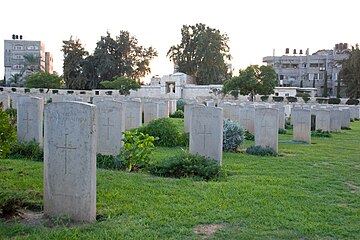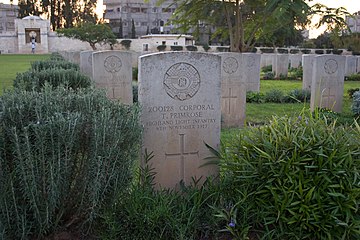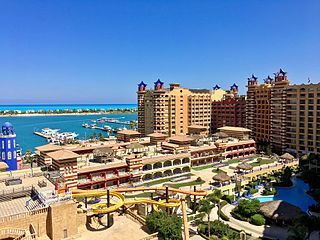
El Alamein is a town in the northern Matrouh Governorate of Egypt. Located on the Mediterranean Sea, it lies 106 kilometres (66 mi) west of Alexandria and 300 kilometres (186 mi) northwest of Cairo. The town is located on the site of the ancient city Antiphrai which was built by the Romans.(Greek: Ἀντίφραι).

The Commonwealth War Graves Commission (CWGC) is an intergovernmental organisation of six independent member states whose principal function is to mark, record and maintain the graves and places of commemoration of Commonwealth of Nations military service members who died in the two World Wars. The commission is also responsible for commemorating Commonwealth civilians who died as a result of enemy action during the Second World War. The commission was founded by Sir Fabian Ware and constituted through royal charter in 1917 as the Imperial War Graves Commission. The change to the present name took place in 1960.

A war grave is a burial place for members of the armed forces or civilians who died during military campaigns or operations.

Sai Wan War Cemetery is a military cemetery located in Chai Wan, Hong Kong which was built in 1946. The cemetery was created to commemorate soldiers of Hong Kong Garrison who perished during the Second World War. The cemetery also contains 12 World War I burials. A total of 1,528 soldiers, mainly from the Commonwealth, are commemorated here. Most of the remaining burials are located at the Stanley Military Cemetery.

Railway Dugouts Burial Ground (Transport Farm) is a Commonwealth War Graves Commission (CWGC) burial ground for the dead of the First World War located in the Ypres Salient on the Western Front.

Belfast City Cemetery is a large cemetery in west Belfast, Northern Ireland. It lies within the townland of Ballymurphy, between Falls Road and Springfield Road, near Milltown Cemetery. Burial records have been fully digitized and are searchable online.

Dieppe Canadian War Cemetery is a Second World War military war grave cemetery, located in the village of Hautot-sur-Mer, 5 km (3.1 mi) south of Dieppe in Normandy, France. It contains Canadian and British soldiers killed during the Dieppe Raid on the 18/19 August 1942. This large scale daylight assault on a fortified objective was an abject failure and casualties were very heavy. Of an attacking military force of some 6,100, over 3,600 were killed, wounded, missing or taken prisoner.
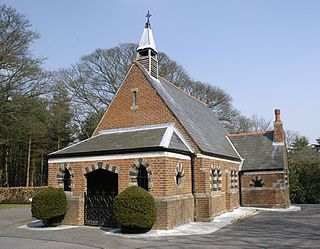
Aldershot Military Cemetery is a burial ground for military personnel, or ex-military personnel and their families, located in Aldershot Military Town, Hampshire.

The Defence Forces Cemetery of Tallinn, sometimes called the Tallinn Military Cemetery, is one of the three cemeteries of the Tallinn City Centre Cemetery. It is situated about 3 kilometres outside the centre of Tallinn, the capital of Estonia. During Estonian independence before the Soviet and German occupations of the 1940–1991 period, it was Estonia's foremost military cemetery.

The East London Cemetery and Crematorium are located in Plaistow in the London Borough of Newham. It is owned and operated by the Dignity Funeral Group.

The St Symphorien Military Cemetery is a First World War Commonwealth War Graves Commission burial ground in Saint-Symphorien, Belgium. It contains the graves of 284 German and 229 Commonwealth soldiers, principally those killed during the Battle of Mons. The cemetery was established by the German Army on land donated by Jean Houzeau de Lehaie. It was initially designed as a woodland cemetery before being redesigned by William Harrison Cowlishaw after the Imperial War Graves Commission took over maintenance of the cemetery after the war.

The West Terrace Cemetery, formerly Adelaide Public Cemetery is a cemetery in Adelaide, South Australia. It is the state's oldest cemetery, first appearing on Colonel William Light's 1837 plan of the Adelaide city centre, to the south-west of the city. The whole cemetery is state heritage-listed, including Smyth Chapel, and it is one of the oldest operating cemeteries in Australia.

Shuja'iyya, also Shejaiya, Shijaiyeh, Shujayya, Shuja'ia, Shuja'iya, is the southern quarter of Old City of Gaza, and the only quarter of the Old City located outside the historical city walls. It is one of the largest neighborhoods in Gaza, once holding 92,000 to 100,000 residents. It is located east of Gaza's city center, and its nucleus is situated on a hill located across the main Salah al-Din Road that runs north–south throughout the Gaza Strip. Shuja'iyya contains several ancient structures, mosques and tombs. The Commonwealth War Cemetery is located 2 kilometres (1.2 mi) north of the commercial center of the neighborhood.

Mierlo War Cemetery is a Second World War Commonwealth war grave cemetery, located in the village of Mierlo, 12 km (7.5 mi) east of Eindhoven in The Netherlands.
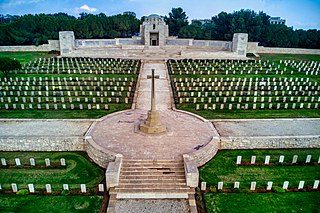
The Jerusalem War Cemetery is a British cemetery in Jerusalem for fallen servicemen of the British Commonwealth in the World War I in the Palestine campaign.

The Basra War Cemetery is a military cemetery in Basra, Iraq, built for soldiers killed during the Mesopotamian campaign in the First World War.

Known unto God is a phrase used on the gravestones of unknown soldiers in Commonwealth War Graves Commission (CWGC) cemeteries. The phrase was selected by British poet Rudyard Kipling who worked for what was then the Imperial War Graves Commission during the First World War. The origin of the phrase is unknown but it has been linked to sections of the King James Bible. The phrase was re-used for those killed during the Second World War and appears on more than 212,000 gravestones across the world. In 2013 there was controversy when it was proposed that the phrase be removed from the Tomb of the Unknown Soldier at the Australian War Memorial.
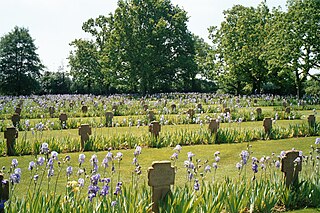
Saint-Désir-de-Lisieux is a Second World War German military war grave cemetery, located close to the village of Saint-Désir and 4 km (2.5 mi) west of Lisieux in the Calvados department, Normandy, France. It is located adjacent to the British Saint-Désir War Cemetery and is unique as the two burial grounds are linked by a pathway. It is the smallest German war cemetery in Normandy and contains the remains of 3,735 German military personnel. The cemetery was created by the British Graves Registration Commission in August 1944 with British and German casualties buried in adjacent fields.
The Baghdad War Cemetery is a cemetery in Baghdad in Iraq. The cemetery contains 4480 interments and commemorations. Many graves are marked by Commonwealth War Graves Commission (CWGC) gravestones. The CWGC graves in the cemetery commemorate military personnel killed in the country in World War I and World War II. In 2012 511 CWGC headstones were repaired with new concrete bases and a new boundary fence was completed.
Israeli forces damaged or destroyed at least 16 cemeteries in the Gaza Strip during the 2023 Israel–Hamas war in various places in Gaza within Palestine, as determined by evidence gathered by CNN, the New York Times and Euro-Med Human Rights Monitor.




